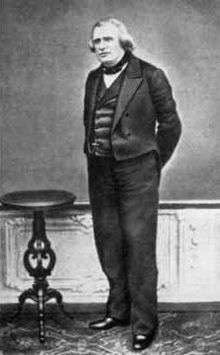Ilya Voznesensky
| Ilya G. Voznesensky | |
|---|---|
 | |
| Native name | Илья́ Гаври́лович Вознесе́нский |
| Born |
June 19, 1816 Saint Petersburg |
| Died | May 18, 1871 (aged 54) |
| Nationality | Russian Empire |
Ilya Gavrilovich Voznesensky (Russian: Илья́ Гаври́лович Вознесе́нский, also romanized as Ilia or Il'ia Voznesenskii or Wosnesenski, June 19, 1816 – May 18, 1871) was a Russian explorer and naturalist associated with the Russian Academy of Sciences who collected biological specimens and cultural artifacts from the Russian Far East and North and South America, known especially for his ten-year expedition in Russian America (parts of present-day Alaska and California), which he explored from 1839 to 1849. The expedition collected around 400 previously unknown species of plant and animals, and established the world's largest collection of ethnological artifacts of Russian America. After the expedition was appointed custodian of the Zoological Museum in St. Petersburg. Voznesensky was a corresponding member of the Russian Geographical Society and one of the founders of the Russian Entomological Society. He was awarded the Order of Saint Stanislaus, third class, in 1856.[1]
References
- ↑ Feklova, Tatyana Yurievna (2014). "The Expedition of Ilya G. Voznesensky to Russian America in 1839–1849 and the Formation of the American Collections in St. Petersburg Academic Museums". Acta Baltica Historiae et Philosophiae Scientiarum. 2 (2): 44–69. doi:10.11590/abhps.2014.2.04.
Further reading
- Alekseev, A. I. (1987). The Odyssey of a Russian Scientist: I. G. Voznesenskii in Alaska, California, and Siberia, 1839-1849. Translated by Wilma C. Follette. Kingston, Ont., Canada: Limestone Press. ISBN 9780919642058.
- Hudson, Travis; Bates, Craig D. (2015). "A Superb Collector Visits California: Il'ia G. Voznesenskii". Treasures from Native California: The Legacy of Russian Exploration. Left Coast Press. pp. 47–50. ISBN 978-1-61132-982-7.